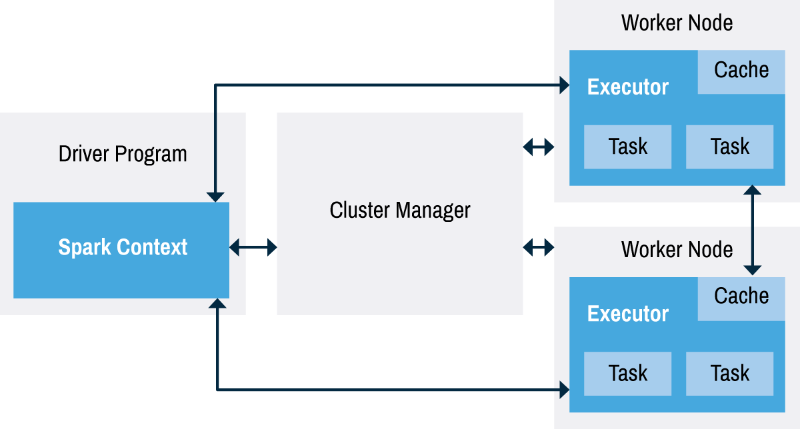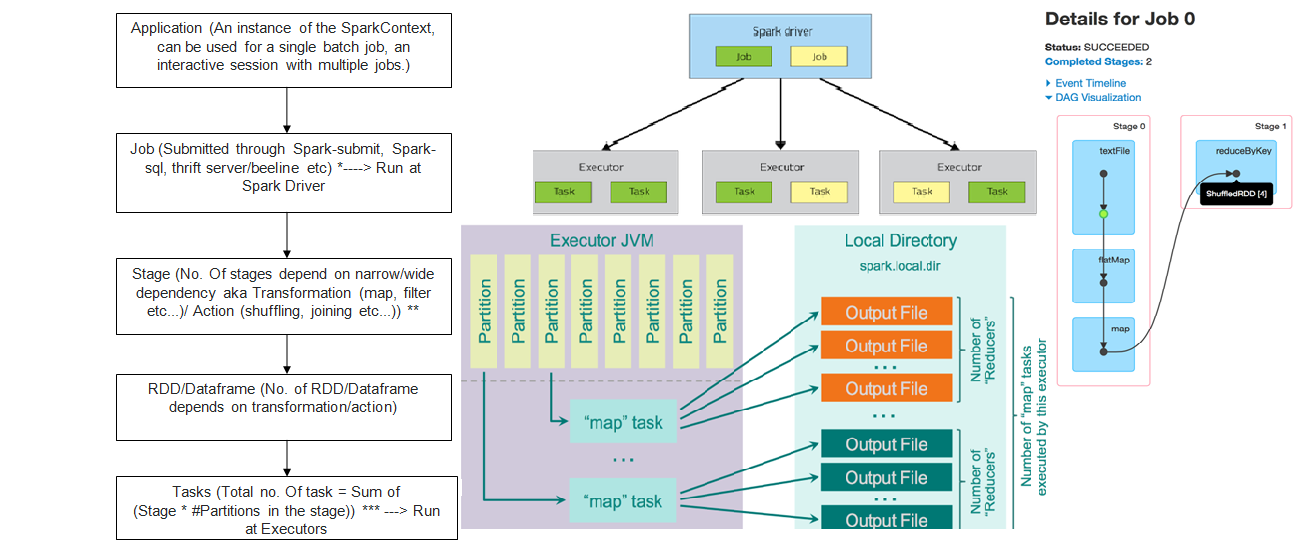Spark是硅谷各大公司都在使用的当红炸子鸡,而且有愈来愈热的趋势,所以大家很有必要了解学习这门技术。本文其实是笔者深入浅出hadoop系列的第三篇,标题里把hadoop去掉了因为spark可以不依赖于Hadoop。Spark可以运行在多种持久化系统之上,比如HDFS, Amazon S3, Azure Storage, Cassandra, Kafka。把深入浅出去掉了是因为Spark功能实在太强大(Spark SQL, Spark Streaming, Spark GraphX, Spark MLlib),本文只能抛砖引玉帮大家节省时间入个门,打算以后分专题深入总结一下sql, graph, streaming和machine learning方面的应用。
Spark History
- 2009 project started at UC berkeley's AMP lab
- 2012 first release (0.5)
- 2014 became top level apache project
- 2014 1.0
- 2015 1.5
- 2016 2.0
Spark 起源
map reduce以及之前系统存在的问题
- cluster memory 没有被有效运用
- map reduce重复冗余使用disk I/O,比如前一个job的output存在硬盘中,然后作为下一个job的input,这部分disk I/O如果都在内存中是可以被节省下来的。这一点在ad hoc query上尤为突出,会产生大量的中间文件,而且completion time比中间文件的durability要更为重要。
- map reduce的job要不停重复的做join,算法写起来要不停的tuning很蛋疼。
- 没有一个一站式解决方案,往往需要好几个系统比如mapreduce用来做batch processing,storm用来做stream processing,elastic search用来做交互式exploration。这就造成了冗余的data copy。
- interactive query和stream processing的需求越来越大,比如需要ad hoc analytics和快速的decision-making
- machine learning的需求越来越多
spark的破解方案
- RDD abstraction with rich API
- 充分使用内存
- 一站式提供Spark SQL, Spark Streaming, Spark GraphX, Spark MLlib
spark 架构

cluster manager: manage to execute tasks could be spark's standalone cluster manager, YARN(参见我之前讲mapreduce的文章) or Mesos。可以用来track当前可用的资源。
Spark applications包括driver process和若干executor processes。driver process是整个spark app的核心,运行main() function, 维护spark application的信息,响应用户输入,分析,distribute并且schedule work across executors。executors用来执行driver分配给它们的task,并把computation state report back to driver。
pyspark 安装
最简单的方式就是在如下地址下载tar包:
https://spark.apache.org/downloads.html
命令行运行:
$ export PYSPARK_PYTHON=python3
$ ./bin/pyspark
Python 3.6.4 (default, Jan 6 2018, 11:51:15)
[GCC 4.2.1 Compatible Apple LLVM 9.0.0 (clang-900.0.39.2)] on darwin
。。。
Welcome to
____ __
/ __/__ ___ _____/ /__
_ / _ / _ `/ __/ '_/
/__ / .__/\_,_/_/ /_/\_ version 2.2.1
/_/
Using Python version 3.6.4 (default, Jan 6 2018 11:51:15)
SparkSession available as 'spark'.
setup:
python setup.py install
导入
from pyspark import SparkConf, SparkContext
RDDs (Resilient Distributed Datasets)
- Resilient: able to withstand failures
- Distributed: spanning across multiple machines
- read-only, partitioned collection of records
RDD 在最新的spark2.x中有逐渐被淡化的趋势,是曾经的主角,现在算作low level API,基本不太可能在生产实践中用到,但是有助于理解spark。新型的RDD需要实现如下接口
- partitions()
- iterator(p: Partition)
- dependencies()
- optional: partitioner for key-value RDD (E.g. RDD is hash-partitioned)
从local collection中创建RDD
>>> mycollection = "Spark Qing Ge Guide : Big Data Processing Made Simple".split(" ") >>> words = spark.sparkContext.parallelize(mycollection, 2) >>> words.setName("myWords") myWords ParallelCollectionRDD[35] at parallelize at PythonRDD.scala:489 >>> words.name() 'myWords'
transformations
distinct:
>>> words.distinct().count() [Stage 23:> (0 + 0) / 2] 10
filter:
>>> words.filter(lambda word: startsWithS(word)).collect() ['Spark', 'Simple']
map:
>>> words2 = words.map(lambda word: (word, word[0], word.startswith("S"))) >>> words2.filter(lambda record: record[2]).take(5) [('Spark', 'S', True), ('Simple', 'S', True)]
flatmap:
>>> words.flatMap(lambda word: list(word)).take(5) ['S', 'p', 'a', 'r', 'k']
sort:
>>> words.sortBy(lambda word: len(word) * -1).take(5) ['Processing', 'Simple', 'Spark', 'Guide', 'Qing']
Actions
reduce:
>>> spark.sparkContext.parallelize(range(1,21)).reduce(lambda x, y : x+y) 210
count:
>>> words.count()
10
first:
>>> words.first() 'Spark'
max and min:
>>> spark.sparkContext.parallelize(range(1,21)).max() 20 >>> spark.sparkContext.parallelize(range(1,21)).min() 1
take:
>>> words.take(5) ['Spark', 'Qing', 'Ge', 'Guide', ':']
注意:spark uses lazy transformation, 上文提到的所有transformation都只有在action时才会被调用。
Saving files
>>> words.saveAsTextFile("file:/tmp/words")
$ ls /tmp/words/ _SUCCESS part-00000 part-00001 $ cat /tmp/words/part-00000 Spark Qing Ge Guide : $ cat /tmp/words/part-00001 Big Data Processing Made Simple
Caching
>>> words.cache()
myWords ParallelCollectionRDD[35] at parallelize at PythonRDD.scala:489
options include: memory only(default), disk only, both
CoGroups
>>> import random >>> distinctChars = words.flatMap(lambda word: word.lower()).distinct() >>> charRDD = distinctChars.map(lambda c: (c, random.random())) >>> charRDD2 = distinctChars.map(lambda c: (c, random.random())) >>> charRDD.cogroup(charRDD2).take(5) [('s', (<pyspark.resultiterable.ResultIterable object at 0x10ab49c88>, <pyspark.resultiterable.ResultIterable object at 0x10ab49080>)), ('p', (<pyspark.resultiterable.ResultIterable object at 0x10ab49438>, <pyspark.resultiterable.ResultIterable object at 0x10ab49048>)), ('r', (<pyspark.resultiterable.ResultIterable object at 0x10ab494a8>, <pyspark.resultiterable.ResultIterable object at 0x10ab495c0>)), ('i', (<pyspark.resultiterable.ResultIterable object at 0x10ab49588>, <pyspark.resultiterable.ResultIterable object at 0x10ab49ef0>)), ('g', (<pyspark.resultiterable.ResultIterable object at 0x10ab49ac8>, <pyspark.resultiterable.ResultIterable object at 0x10ab49da0>))]
Inner Join
>>> keyedChars = distinctChars.map(lambda c: (c, random.random())) >>> outputPartitions = 10 >>> chars = words.flatMap(lambda word: word.lower()) >>> KVcharacters = chars.map(lambda letter: (letter, 1)) >>> KVcharacters.join(keyedChars).count() 44 >>> KVcharacters.join(keyedChars, outputPartitions).count() 44
Aggregations
from functools import reduce >>> def addFunc(left, right): ... return left + right ... KVcharacters.groupByKey().map(lambda row: (row[0], reduce(addFunc, row[1]))).collect() [('s', 4), ('p', 3), ('r', 2), ('i', 5), ('g', 5), ('d', 3), ('b', 1), ('c', 1), ('l', 1), ('a', 4), ('k', 1), ('q', 1), ('n', 2), ('e', 5), ('u', 1), (':', 1), ('t', 1), ('o', 1), ('m', 2)]
Spark 执行和调度

具体来说就是
- invoke an action...
- ...spawns the job...
- ...that gets divided into the stages by the job scheduler...
- ...and tasks are created for every job stage
其中,stage和task的区别在于:stage是RDD level,不会被立即执行,而task会被立即执行。
Broadcast variables
- read-only shared variables with effective sharing mechanism
- useful to share dictionaries and models
今天就先到这,更多内容以后有机会再聊